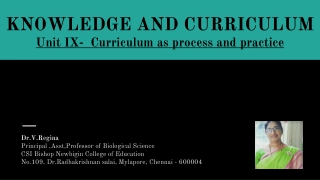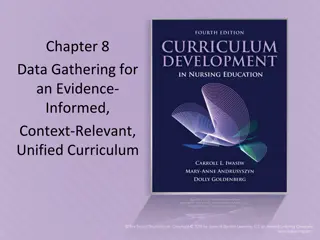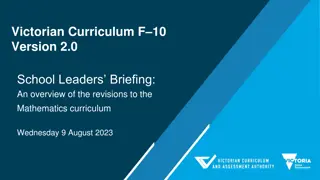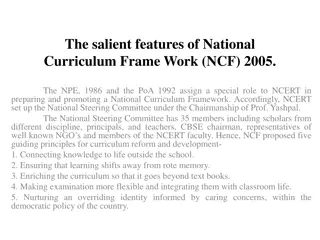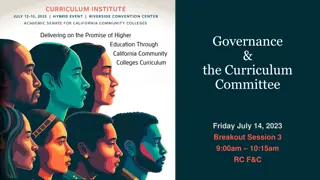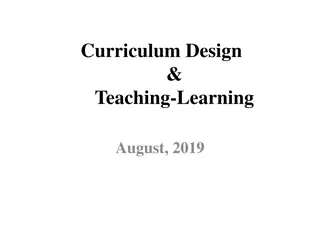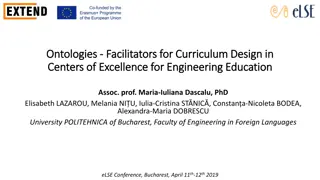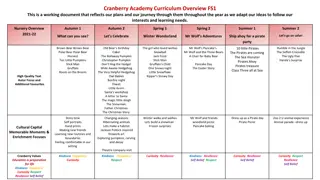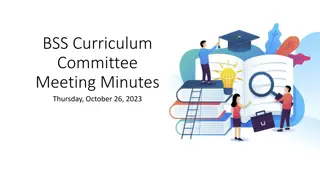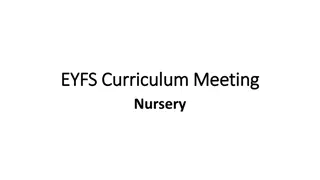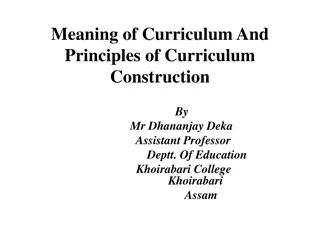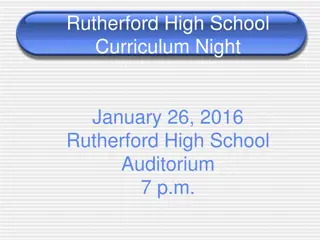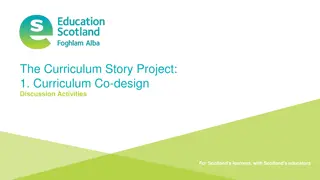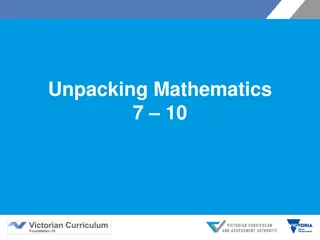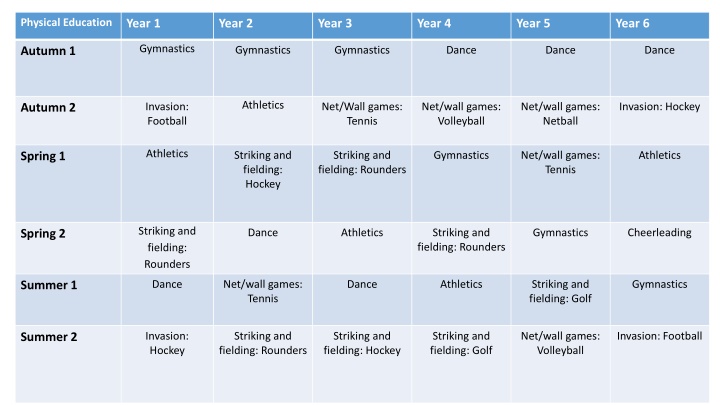
Physical Education Curriculum and Early Years Development Focus
Explore the curriculum for physical education across different year levels, including activities like gymnastics, dance, athletics, and various games. Additionally, dive into the focus on physical development during the Early Years Foundation Stage (EYFS), covering key milestones and activities to support children's motor skills and creativity.
Download Presentation

Please find below an Image/Link to download the presentation.
The content on the website is provided AS IS for your information and personal use only. It may not be sold, licensed, or shared on other websites without obtaining consent from the author. If you encounter any issues during the download, it is possible that the publisher has removed the file from their server.
You are allowed to download the files provided on this website for personal or commercial use, subject to the condition that they are used lawfully. All files are the property of their respective owners.
The content on the website is provided AS IS for your information and personal use only. It may not be sold, licensed, or shared on other websites without obtaining consent from the author.
E N D
Presentation Transcript
Physical Education Year 1 Year 2 Year 3 Year 4 Year 5 Year 6 Gymnastics Gymnastics Gymnastics Dance Dance Dance Autumn 1 Athletics Invasion: Football Net/Wall games: Tennis Net/wall games: Volleyball Net/wall games: Netball Invasion: Hockey Autumn 2 Athletics Striking and fielding: Hockey Striking and fielding: Rounders Gymnastics Net/wall games: Tennis Athletics Spring 1 Striking and fielding: Rounders Dance Athletics Striking and fielding: Rounders Gymnastics Cheerleading Spring 2 Dance Net/wall games: Tennis Dance Athletics Striking and fielding: Golf Gymnastics Summer 1 Invasion: Hockey Striking and fielding: Rounders Striking and fielding: Hockey Striking and fielding: Golf Net/wall games: Volleyball Invasion: Football Summer 2
PE NURSERY AUTUMN AUTUMN SPRING SPRING SUMMER SUMMER Throughout EYFS focus is to be placed on the statutory framework for EYFS and the ELG. In nursery the particular focus is on the prime areas- Personal, social an emotional, Communication and Language and Physical Development. FOCUS How do I move my body? QUESTION Physical Development (PD) 22-36 months Runs safely on whole foot. Squats with steadiness to rest or play with object on the ground, and rises to feet without using hands. Climbs confidently and is beginning to pull themselves up on nursery play climbing equipment. Can kick a large ball. Turns pages in a book, sometimes several at once. Shows control in holding and using jugs to pour, hammers, books and mark-making tools. Beginning to use three fingers (tripod grip) to hold writing tools Imitates drawing simple shapes such as circles and lines. Walks upstairs or downstairs holding onto a rail two feet to a step. May be beginning to show preference for dominant hand Physical Development 30-50 months Moves freely and with pleasure and confidence in a range of ways, such as slithering, shuffling, rolling, crawling, walking, running, jumping, skipping, sliding and hopping. Mounts stairs, steps or climbing equipment using alternate feet. Walks downstairs, two feet to each step while carrying a small object. Runs skilfully and negotiates space successfully, adjusting speed or direction to avoid obstacles. Can stand momentarily on one foot when shown. Can catch a large ball. Draws lines and circles using gross motor movements. Uses one-handed tools and equipment, e.g. makes snips in paper with child scissors. Holds pencil between thumb and two fingers, no longer using whole-hand grasp. Holds pencil near point between first two fingers and thumb and uses it with good control. Can copy some letters, e.g. letters from their name. Expressive Arts and Design (EAD) 30-50 months Enjoys joining in with dancing and ring games. Sings a few familiar songs. Beginning to move rhythmically. Expressive Arts and Design 40-50 months Imitates movement in response to music KEY KNOWLEDGE PD: Plan opportunities for children to tackle a range of levels and surfaces including flat and hilly ground, grass, pebbles, asphalt, smooth floors and carpets. Provide a range of large play equipment that can be used in different ways, such as boxes, ladders, A-frames and barrels. Plan time for children to experiment with equipment and to practise movements they choose. Provide safe spaces and explain safety to children and parents. Provide real and role-play opportunities for children to create pathways, e.g. road layouts, or going on a picnic. Provide CD and tape players, scarves, streamers and musical instruments so that children can respond spontaneously to music. Plan activities that involve moving and stopping, such as musical bumps. Provide tool boxes containing things that make marks, so that children can explore their use both indoors and outdoors. EAD: Lead imaginative movement sessions based on children s current interests such as space travel, zoo animals or shadows. Introduce children to a wide range of music, painting and sculpture. ACQUIRING AND DEVELOPING SKILLS Be aware that children can be very energetic for short bursts and need periods of rest and relaxation. Value the ways children choose to move. Give as much opportunity as possible for children to move freely between indoors and outdoors. Talk to children about their movements and help them to explore new ways of moving, such as squirming, slithering and twisting along the ground like a snake, and moving quickly, slowly or on tiptoe. Encourage body tension activities such as stretching, reaching, curling, twisting and turning. Be alert to the safety of children, particularly those who might overstretch themselves. Encourage children in their efforts to do up buttons, pour a drink, and manipulate objects in their play, e.g. Can you put the dolly s arm in the coat? EVALUATING AND IMPROVING
PE RECEPTION AUTUMN AUTUMN SPRING SPRING SUMMER SUMMER Throughout EYFS focus is to be placed on the statutory framework for EYFS and the ELG. In Reception this includes Personal, Social and Emotional, Communication and Language, Physical Development, Literacy, Maths, Understanding the World and Expressive Arts and Design. FOCUS What happens to my body when I move? QUESTION Physical Development (PD) 30-50 months Moves freely and with pleasure and confidence in a range of ways, such as slithering, shuffling, rolling, crawling, walking, running, jumping, skipping, sliding and hopping. Mounts stairs, steps or climbing equipment using alternate feet. Walks downstairs, two feet to each step while carrying a small object. Runs skilfully and negotiates space successfully, adjusting speed or direction to avoid obstacles. Can stand momentarily on one foot when shown. Can catch a large ball. Draws lines and circles using gross motor movements. Uses one-handed tools and equipment, e.g. makes snips in paper with scissors. Holds pencil between thumb and two fingers, no longer using whole-hand grasp. Holds pencil near point between first two fingers and thumb and uses it with good control. Can copy some letters, e.g. letters from their name. Expressive Arts and Design (EAD) 30-50 months Enjoys joining in with dancing and ring games. Sings a few familiar songs. Beginning to move rhythmically. Imitates movement in response to music Physical Development (PD) 40-60 months Experiments with different ways of moving. Jumps off an object and lands appropriately. Negotiates space successfully when playing racing and chasing games with other children, adjusting speed or changing direction to avoid obstacles. Travels with confidence and skill around, under, over and through balancing and climbing equipment. Shows increasing control over an object in pushing, patting, throwing, catching or kicking it. Uses simple tools to effect changes to materials. Handles tools, objects, construction and malleable materials safely and with increasing control. Shows a preference for a dominant hand. Begins to use anticlockwise movement and retrace vertical lines. Begins to form recognisable letters. Uses a pencil and holds it effectively to form recognisable letters, most of which are correctly formed. Early Learning Goal Children show good control and co-ordination in large and small movements. They move confidently in a range of ways, safely negotiating space. They handle equipment and tools effectively, including pencils for writing. Expressive Arts and Design 40-60 months Initiates new combinations of movement and gesture in order to express and respond to feelings, ideas and experiences. Early Learning Goal Children sing songs, make music and dance, and experiment with ways of changing them. They safely use and explore a variety of materials, tools and techniques, experimenting with colour, design, texture, form and function. KEY KNOWLEDGE PD: Provide time and space to enjoy energetic play daily. Provide large portable equipment that children can move about safely and cooperatively to create their own structures, such as milk crates, tyres, large cardboard tubes. Practise movement skills through games with beanbags, cones, balls and hoops. Plan activities where children can practise moving in different ways and at different speeds, balancing, target throwing, rolling, kicking and catching Provide sufficient equipment for children to share, so that waiting to take turns does not spoil enjoyment. Mark out boundaries for some activities, such as games involving wheeled toys or balls, so that children can more easily regulate their own activities. Provide activities that give children the opportunity and motivation to practise manipulative skills, e.g. cooking, painting, clay and playing instruments. Provide play resources including small world toys, construction sets, threading and posting toys, dolls clothes and material for collage. Teach children skills of how to use tools and materials effectively and safely and give them opportunities to practise them. Provide a range of left-handed tools, especially left-handed scissors, as needed. Support children with physical difficulties with nonslip mats, small trays for equipment, and triangular or thicker writing tools. Provide a range of construction toys of different sizes, made of wood, rubber or plastic, that fix together in a variety of ways, e.g. by twisting, pushing, slotting or magnetism. ACQUIRING AND DEVELOPING SKILLS Encourage children to move with controlled effort, and use associated vocabulary such as strong , firm , gentle , heavy , stretch , reach , tense and floppy . Use music of different styles and cultures to create moods and talk about how people move when they are sad, happy or cross. Motivate children to be active through games such as follow the leader. Talk about why children should take care when moving freely. Teach children the skills they need to use equipment safely, e.g. cutting with scissors or using tools. Encourage children to use the vocabulary of movement, e.g. gallop , slither ; of instruction e.g. follow , lead and copy . w Pose challenging questions such as Can you get all the way round the climbing frame without your knees touching it? Talk with children about the need to match their actions to the space they are in. Show children how to collaborate in throwing, rolling, fetching and receiving games, encouraging children to play with one another once their skills are sufficient. Introduce and encourage children to use the vocabulary of manipulation, e.g. squeeze and prod. Explain why safety is an important factor in handling tools, equipment and materials, and have sensible rules for everybody to follow. EVALUATING AND IMPROVING
PE Y1 AUTUMN AUTUMN SPRING SPRING SUMMER SUMMER Gymnastics Invasion: Football Athletics Striking and Fielding: Rounders Dance Invasion: Hockey FOCUS How many shapes can I make with my body? What different ways can I kick and throw a ball? What hazards do I need to look for to ensure I am safe? Can I throw a ball further with my left or right hand? How does different styles of music affect how I move my body? Doesthe way I move affect the speed of a ball? QUESTION Make curled, stretched relaxed. Control when travelling and relaxing. Copy sequences and repeat them. Roll, curl, travel and balance in different ways. my body Throw and kick in different ways. Move safely in a space Throw underarm Hit a ball with a bat Throw and catch a ball with both hands. Move to music Copy dance moves Perform my own dance moves Make up a short dance Move safely in a space Roll, curl, balance in different ways. KEY KNOWLEDGE tensed, and travel and Move and stop safely my body KS1 National Curriculum Physical Education Programme of Study Master basic movements including running, jumping, throwing and catching, as well as developing balance, agility and co-ordination, and begin to apply these in a range of activities; participate in team games, developing simple tactics for attacking and defending; perform dances using simple movement patterns. Can the children copy actions? Can the children repeat actions and skills? Can the children move with control? ACQUIRING AND DEVELOPING SKILLS Can the children talk about what they have done? Can the children describe what other people did? EVALUATING AND IMPROVING Can the children describe how their body feels before, during and after activity? HEALTH AND FITNESS
PE Y2 AUTUMN AUTUMN SPRING SPRING SUMMER SUMMER Gymnastics Athletics Invasion Games: Hockey Dance Net/Wall Games: Tennis Striking and Fielding: Rounders FOCUS How many ways can I move from one shape to another? Does working with a partner change the space I need to work in safely? Do I need to apply different tactics for attacking and defending? How do you feel when you move to different styles of music? Do I need to apply different tactics for attacking and defending? Does the way I hit the ball change it s direction? QUESTION Plan and perform a sequence movement. Improve sequence based on feedback. Think of more than one way to create a sequence follows some rules. Work on my own and with a partner. Work on my own and with a partner. Decide the best space to be in during a game. Decide the best space to be in during a game. Use one tactic in a game and follow rules. Change rhythm, speed, level and direction in a dance. Dance with control and coordination Make a sequence linking sections together, Use a dance to show a mood or feeling. Decide the best space to be in during a game. Use one tactic in a game and follow rules. Use hitting, kicking and/ or rolling in a game. KEY KNOWLEDGE of my by that KS1 National Curriculum Physical Education Programme of Study Master basic movements including running, jumping, throwing and catching, as well as developing balance, agility and co-ordination, and begin to apply these in a range of activities; participate in team games, developing simple tactics for attacking and defending; perform dances using simple movement patterns. Can the children copy and remember actions? Can the children repeat and explore actions with control and coordination? ACQUIRING AND DEVELOPING SKILLS Can the children talk about what is different between what they did and what someone else did? Can the children say how they could improve? EVALUATING AND IMPROVING Can the children show how to exercise safely? Can the children describe how their body feels during different activities? Can the children explain what their body needs to keep healthy? HEALTH AND FITNESS
PE Y3 AUTUMN AUTUMN SPRING SPRING SUMMER SUMMER Gymnastics Net/Wall Games: Tennis Striking and fielding: Rounders Athletics Dance Invasion Games: Hockey FOCUS How does the apparatus affect how I sequence my movements? Can I control a catch better with one or two hands? How does my performance affect my team? Which events need strength from the upper/lower body? Do my peers move differently to me to a piece of music? How can I support my team effectively? QUESTION Adapt suit different types of apparatus. Explain how strength and suppleness affect performance. Compare and contrast gymnastic sequences. sequences to Throw and catch with control. Know and use rules fairly Throw and catch with control. Am aware of space and use it to support team mates. Know and use rules fairly Explain how strength and suppleness affect performance. Am aware of space and use it to support team mates. Improvise translate ideas from a stimulus to a movement. Share and create phases with a partner and a small group. Repeat, remember and perform phases. feely and Throw and catch with control. Am aware of space and use it to support team mates. Know and use rules fairly KEY KNOWLEDGE KS2 National Curriculum Physical Education Programme of Study Use running, jumping, throwing and catching in isolation and in combination; play competitive games, modified where appropriate [for example, badminton, basketball, cricket, football, hockey, netball, rounders and tennis], and apply basic principles suitable for attacking and defending; develop flexibility, strength, technique, control and balance [for example, through athletics and gymnastics]; perform dances using a range of movement patterns; take part in outdoor and adventurous activity challenges both individually and within a team; compare their performances with previous ones and demonstrate improvement to achieve their personal best. Can the children select and use the most appropriate skills, actions, or ideas? Can the children move and use actions with co-ordination and control? ACQUIRING AND DEVELOPING SKILLS Can the children explain how their work is similar and different from that of others? With help, do the children recognise how performances could be improved? EVALUATING AND IMPROVING Can the children explain why it is important to warm-up and cool-down? Can the children identify some muscle groups used in gymnastic activities? HEALTH AND FITNESS
PE Y4 AUTUMN AUTUMN SPRING SPRING SUMMER SUMMER Dance Net/wall games: Volleyball Gymnastics Striking and fielding: Rounders Athletics Striking and fielding: Golf FOCUS How can my ideas influence others and their performances? How can I change my stance to gain more control when throwing and catching? How do I ensure my movement changes are fluid through a sequence? Am I able to adapt my tactics during a game to improve my performance? Am I able to pace myself according to a specific event? E.g. sprint vs long distance running. Am I able to adapt my tactics during a game to improve my performance? QUESTION Take the lead when working group. Use dance communicate idea. Throw accurately. Catch with one hand. Hit a ball accurately with control. Keep possession of a ball. Vary tactics and adapt skills depending on the state of the game. and catch Work in a controlled way Include changes of speed and direction Include a range of shapes Work with a partner to create, repeat improve a sequence with at least 3 phases. Catch with one hand. Hit a ball accurately with control. Vary tactics and adapt skills depending on the state of the game. Work in a controlled way Include changes speed and direction Vary tactics and adapt skills depending on the state of the game. Hit a ball accurately with control. Vary tactics and adapt skills depending on the state of the game. KEY KNOWLEDGE with a of to an and KS2 National Curriculum Physical Education Programme of Study Use running, jumping, throwing and catching in isolation and in combination; play competitive games, modified where appropriate [for example, badminton, basketball, cricket, football, hockey, netball, rounders and tennis], and apply basic principles suitable for attacking and defending; develop flexibility, strength, technique, control and balance [for example, through athletics and gymnastics]; perform dances using a range of movement patterns; take part in outdoor and adventurous activity challenges both individually and within a team; compare their performances with previous ones and demonstrate improvement to achieve their personal best. Can the children select and use the most appropriate skills, actions and ideas? Can the children move and use actions with coordination and control? Can the children make up their own small sided game? ACQUIRING AND DEVELOPING SKILLS Can the children explain how their work is similar and different from that of others? Can they use their comparison to improve their work? EVALUATING AND IMPROVING Can the children explain why warming up is important? Can the children explain why keeping fit is good for their health? HEALTH AND FITNESS
PE Y5 AUTUMN AUTUMN SPRING SPRING SUMMER SUMMER Dance Net/Wall Games: Netball Net/Wall Games: Tennis Gymnastics Striking and fielding: Golf Net/Wall Games: Volleyball FOCUS Am I able to edit my ideas to ensure fluidity of my movements an accompaniment? Do I know the most effective techniques to gain and keep possession of the ball? What different techniques can I use to produce more power when returning the ball? Can I develop a sequence that I am confident to perform to an audience? Do I know the most effective techniques to use for the various elements of the game? Do I know the most effective techniques to gain and keep possession of the ball? QUESTION Compose dances in a creative way. Perform accompaniment. Show clarity, fluency, accuracy consistency my own dance. my own Gain possession, working in a team. Pass in different ways and use a number of different techniques to pass, dribble, shoot. Choose a attacking and defending. Gain possession, working in a team. Pass in different ways and use a number of different techniques to pass, dribble, shoot. Use backhand forehand with a racquet. Make extended sequences. Combine balance and shape. Perform consistently to audiences. complex and Pass in different ways and use a number of different techniques to pass, dribble, shoot. Pass in different ways and use a number of different techniques to pass, dribble, shoot. KEY KNOWLEDGE action, to an and tactic for and through KS2 National Curriculum Physical Education Programme of Study Use running, jumping, throwing and catching in isolation and in combination; play competitive games, modified where appropriate [for example, badminton, basketball, cricket, football, hockey, netball, rounders and tennis], and apply basic principles suitable for attacking and defending; develop flexibility, strength, technique, control and balance [for example, through athletics and gymnastics]; perform dances using a range of movement patterns; take part in outdoor and adventurous activity challenges both individually and within a team; compare their performances with previous ones and demonstrate improvement to achieve their personal best. Can the children link skills, techniques and ideas and apply them accurately and appropriately? Do the children show good control in their movements? ACQUIRING AND DEVELOPING SKILLS Can the children compare and comment on skills, techniques and ideas that they and others have used? Can the children use their observations to improve their work? EVALUATING AND IMPROVING Can the children explain some important safety principles when preparing for exercise? Can the children explain what effect exercise has on their body? Can the children explain why exercise is important? HEALTH AND FITNESS
PE Y6 AUTUMN AUTUMN SPRING SPRING SUMMER SUMMER Dance Invasion Games: Hockey Athletics Cheerleading Gymnastics Invasion Games: Football FOCUS Is my dance piece a reflection of me and a culmination of the skills I have acquired and perfected? What are the elements of being a fair and respectful competitor? What are the elements of being a fair and respectful competitor? How can I combine my ideas with others to create the best final performance piece? How can I combine my ideas with others to create the best final performance piece? What are the elements of being a fair and respectful competitor? QUESTION Develop sequences in a specific style, Choose my own music and style. Play to agreed rules Explain umpire. Lead others in a games situation. Play to agreed rules Explain umpire. Lead others in a games situation. Combine my own work with that of others. Develop sequences in a specific style, Choose my own music and style. Combine my own work with that of others. Link sequences specific things. Play to agreed rules Explain umpire. Lead others in a games situation. KEY KNOWLEDGE rules, and rules, and rules, and to KS2 National Curriculum Physical Education Programme of Study Use running, jumping, throwing and catching in isolation and in combination; play competitive games, modified where appropriate [for example, badminton, basketball, cricket, football, hockey, netball, rounders and tennis], and apply basic principles suitable for attacking and defending; develop flexibility, strength, technique, control and balance [for example, through athletics and gymnastics]; perform dances using a range of movement patterns; take part in outdoor and adventurous activity challenges both individually and within a team; compare their performances with previous ones and demonstrate improvement to achieve their personal best. Do the children apply their skills, techniques and ideas consistently? Do the children show precision, control and fluency? ACQUIRING AND DEVELOPING SKILLS Can the children analyse and explain why they have used specific skills and techniques? Can the children modify use of skills or techniques to improve their work? Can the children create their own success criteria for evaluating? EVALUATING AND IMPROVING Can the children explain how the body reacts to different kinds of exercise? Can the children choose appropriate warm ups and cool-downs? Can the children explain why we need regular and safe exercise? HEALTH AND FITNESS

